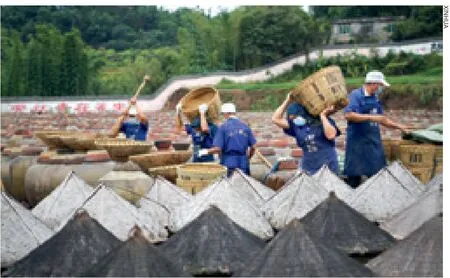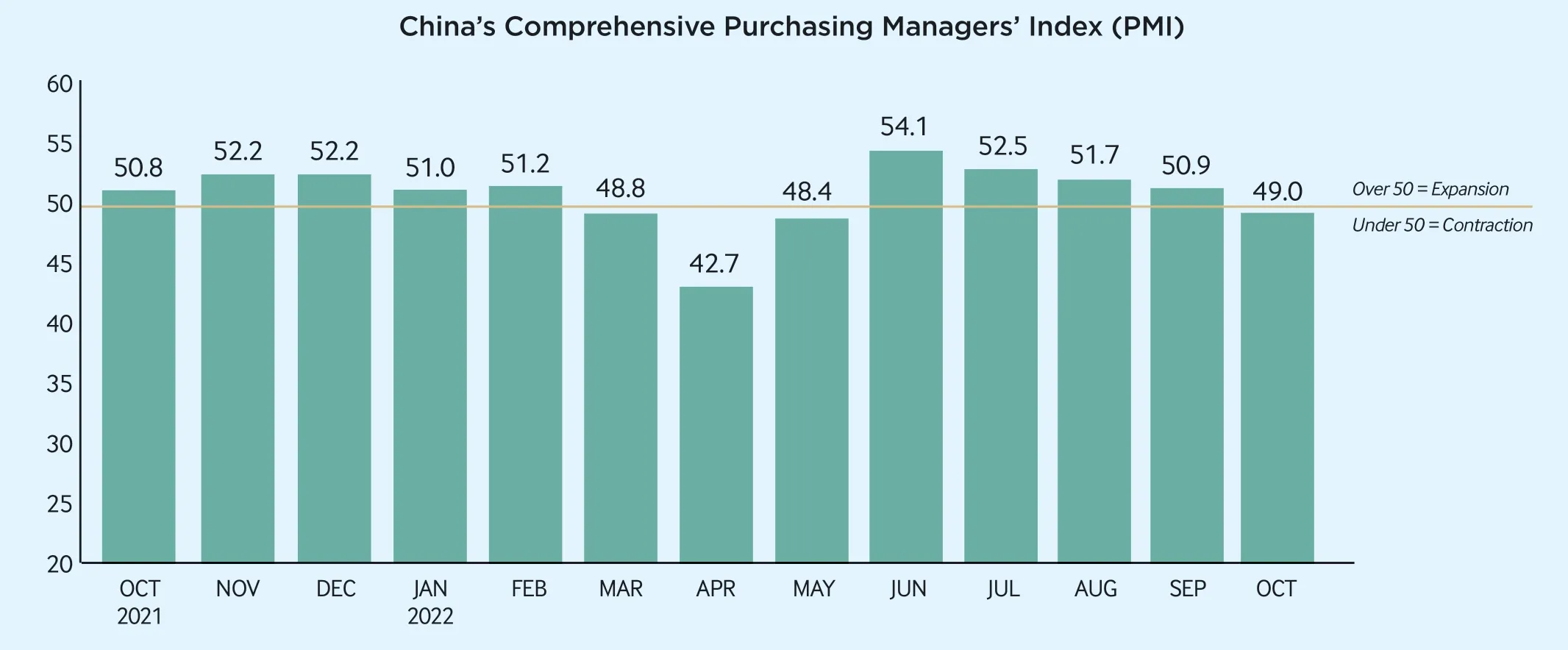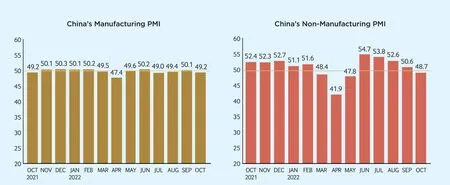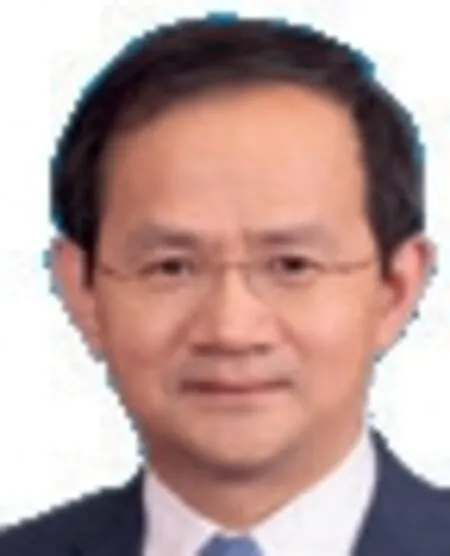THIS WEEK
2022-11-09

Search and Rescue Drill A helicopter practices a rescue operation during a maritime search and rescue drill in the Pearl River in Guangdong Province on October 27. The drill drew the participation of 28 vessels, three aircraft and around 500 staff members.
Better Communities
China has issued a circular on piloting the construction of urban communities with better facilities,services and management amid efforts to improve urban living environments, Xinhua News Agency reported on November 1.
The two-year pilot program started in October 2022, according to the circular jointly issued by the Ministry of Housing and Urban-Rural Development and the Ministry of Civil Affairs.
Communities in the program will be equipped with service facilities, including kindergartens,stations for the elderly and health care, convenience stores,canteens and domestic service outlets, said the circular.
Infrastructure will be upgraded in the fields of utilities,parking and charging, barrierfree facilities and roads.
Efforts will also be made to introduce smart services and management with the support of advanced technology, while residents will be encouraged to participate in community development, the document said.
World Cities Day
Shanghai hosted the Global Observance of World Cities Day 2022 on October 31, along with the Second Sustainable Development Goals Cities Global Conference.
Shanghai held the World Cities Day event eight years after it was first launched in the city in 2014. This year’s event is themed Act Local to Go Global.
The event was co-hosted by the Ministry of Housing and Urban-Rural Development(MHURD), the Shanghai Municipal Government and the United Nations Human Settlements Programme(UNHSP).
Maimunah Mohd Sharif,Executive Director of the UNHSP,addressed the event via video link and released this year’s edition of the Shanghai Manual:A Guide for Sustainable Urban Development in the 21st Century.
The UNHSP, the MHURD and the Shanghai Municipal Government have jointly set up an award for cities that have made outstanding progress in sustainable development. The award will be first presented in 2023.The idea of World Cities Day was proposed by the Shanghai Declaration issued at the Shanghai World Expo in 2010, to advocate the idea of Better City, Better Life. The Day is celebrated annually on October 31.
New Railway
A total of 2,381 km of new railway lines were put into operation across China in the first three quarters of this year, according to the country’s railway operator.
That figure includes 1,198 km of new high-speed tracks, data from China State Railway Group Co. Ltd. showed on October 31.
During the period, the country injected 475 billion yuan($66.19 billion) of fixed-asset investment into the railway sector,the operator said.
China plans to launch new rail lines totaling 3,300 km this year, according to the Ministry of Transport. By the end of last year, the total operating length of China’s high-speed railway network had exceeded 40,000 km.
Foreign-Related Lawsuits
The number of cases involving foreign parties handled by Chinese courts has significantly increased over the past decade,said a report from China’s top court.
The report was submitted by the Supreme People’s Court (SPC)on October 25 to the 37th Session of the Standing Committee of the 13th National People’s Congress for deliberation.
Zhou Qiang, President of the SPC, said in the report that since the 18th National Congress of the Communist Party of China, the number of foreign-related firstinstance civil and commercial cases received by Chinese courts has grown from 14,800 in 2013 to 27,300 in 2021.
From 2013 to June 2022,courts at all levels across the country have concluded a total of 384,000 cases involving foreign parties or parties from Hong Kong, Macao, and Taiwan,the report showed.
China’s foreign-related trials now cover more countries and regions worldwide, and there is a growing number of litigants overseas opting for Chinese courts’jurisdiction, noted Zhou.
The country’s judicial work in foreign-related areas has gained more credibility worldwide, Zhou said.
TCM Personnel
By 2025, the number of traditional Chinese medicine (TCM)personnel in China’s medical and healthcare institutions will surpass 1 million, according to a TCM-related talent development plan, Xinhua reported on October 28.
The workforce of TCM healthcare services will grow steadily, and people’s demand for such services will be
largely fulfilled by then, said the plan issued by the National Administration of Traditional Chinese Medicine.
The number of TCM practicing physicians (physician assistants) will reach 0.62 per 1,000 people as of 2025, and the amount of high-caliber TCM professionals will continuously increase, said the plan.
By then, all the communitybased healthcare centers in urban areas and over 80 percent of village-level clinics in rural areas will be capable of providing TCM-related services, according to the plan.
Archaeological Discovery
Archaeologists have unearthed a large ring trench and adult burial plots dating back to the late Yangshao Culture period in the city of Xianyang in Shaanxi Province, Xinhua reported on November 2.
These remains were discovered at the Jiangliu Site this year when the Shaanxi Academy of Archaeology conducted archaeological studies in Jiangliu Village, Jingyang County of Xianyang.
The excavation work showed that the northern part of the ring trench had been devastated due to the collapse of river valleys,while the semicircular remains of the southern part measures about 1,200 meters in length.The remaining ruins in the trench,where some pottery shards were discovered, covers an area of about 200,000 square meters.

Traditional Techniques Workers move raw materials at the sunning field of a vinegar factory in Chishui, Guizhou Province, on October 28. The production techniques of the vinegar, featuring the sunning process, were listed as a provincial intangible cultural heritage of Guizhou in 2009, and a national one in 2021.
Archaeologists also found 58 adult burial plots on the outside of the southwest section of the trench, while a large number of funeral objects, including bone tools, jade articles, stone tools and accessories and potteries were unearthed.
The discovery of the large trench and adult burial plots at the site is of great significance in archaeological research of the late Yangshao Culture, as it provides important materials for the study of the community pattern and social structure in central Shaanxi at that time,said Shao Jing, a researcher with the Shaanxi Academy of Archaeology.
The Yangshao Culture, dating back 5,000 to 7,000 years,was a Neolithic culture which originated along the middle reaches of the Yellow River. It is widely known for its advanced pottery-making technology.

Experiencing ExcavationA child practices archaeological excavation work near the Liulihe relic site in Beijing on October 30. The site, in Fangshan District, is believed to be the capital of the Yan Kingdom during the Western Zhou Dynasty (1046-771 B.C.).
VR Plan
By 2026, the total value of China’s virtual reality (VR) industry, including related hardware,software and applications, will exceed 350 billion yuan ($48.56 billion), according to a plan jointly issued by the Ministry of Industry and Information Technology and four relevant departments on November 1.
Meanwhile, the plan aims to cultivate 100 enterprises with strong innovation ability and industry influence, while the sales of VR terminals is aimed to top 25 million units.
China also plans to build 10 leading VR industrial clusters with regional influence and 10 industrial public service platforms to foster the sector’s development.
Another target is to make breakthroughs in key technologies and applications as of 2026.
Farm Produce Trade
The foreign trade volume of China’s agricultural products totaled $248.51 billion in the first nine months of 2022, up 10.4 percent year on year, according to the Ministry of Agriculture and Rural Affairs.
Exports jumped 21.5 percent over the same period last year,while imports rose 6.4 percent.
The agriculture sector saw its industrial added value up 4.2 percent year on year during the period.
Listed Firms Profit
China’s listed companies raked in 4.75 trillion yuan ($659 billion)of net profit in the first three quarters of this year, up 2.46 percent year on year, data from the China Association for Public Companies showed.
Their total business revenue grew 8.51 percent over a year ago to 52.37 trillion yuan ($7.27 trillion), the association said, citing financial statements of 4,945 firms listed on the Shanghai,Shenzhen and Beijing stock exchanges.
Non-financial listed companies posted higher revenue growth than financial firms during the period. Firms on the Beijing Stock Exchange led the revenue growth, while those on the Shanghai bourse’s sci-tech innovation board posted the highest net profit expansion.
In the third quarter alone,the revenue and net profit of the companies rose 7.09 percent and 0.69 percent, respectively.
Net profit of firms in industries including wholesale and retail, photovoltaic power, power battery and new-energy vehicles recorded stellar performance in the July-September period, the data showed.
China’s financial market added 300 listed firms in the first nine months, among which 246 were listed through a registration-based initial public offering system to raise more than 360 billion yuan ($50 billion).
Road Projects
There were 299 new expressway and national highway projects initiated in the first nine months of the year, with a combined length of 9,645 km, according to the Ministry of Transport(MOT).
The total investment in these projects was 882.6 billion yuan($122 billion), Gu Zhifeng, an MOT official, told a press conference on October 31.
In September alone, 34 major new road projects were launched, Gu said, adding that their investment totaled 385.3 billion yuan ($53.51 billion),skyrocketing approximately 277 percent over the previous month.
Gu said the ministry would continue to expand investment and accelerate the implementation of major road projects to better leverage the role of key projects in stabilizing the economy.
Top Shipbuilder
China’s shipbuilding industry continued to lead globally in the first three quarters of thisyear, boasting the biggest international market share in terms of output and new and holding orders, official data showed.

NUMBERS($1=7.24 yuan as of November 3)
The country’s shipbuilding output reached 27.8 million deadweight tons in the period,accounting for 45.9 percent of the global total, according to the Ministry of Industry and Information Technology.
New orders in China’s shipbuilding sector took up 53.6 percent of the overall orders globally, while its holding shipbuilding orders accounted for 48 percent of the global total, the ministry said.
In the same period, the industrial output of the country’s 75 key shipbuilding enterprises totaled 291.3 billion yuan ($40.6 billion), according to the China Association of the National Shipbuilding Industry.
These firms raked in 3.22 billion yuan ($447 million) of revenue in the first three quarters,up 220.9 percent from the same period last year.
Renewable Energy
Nationwide installed capacity of renewable energy registered rapid growth in the first nine months of the year amid the country’s pursuit of green development,according to the National Energy Administration.
In the January-September period, the installed capacity of wind power increased 16.9 percent year on year to around 350 million kW, while that of solar power generation came in at 360 million kW, up 28.8 percent.
By the end of September, the country’s total installed power generation capacity reached approximately 2.48 billion kW,rising 8.1 percent from a year ago, the data showed.
China has announced that it will peak carbon dioxide emissions before 2030 and achieve carbon neutrality before 2060.
The country leads globally in installed capacities of wind,photovoltaic, hydro, and biomass power.
FDI Inflow
Paid-in foreign direct investment (FDI) into the Chinese mainland expanded 15.6 percent year on year to exceed 1 trillion yuan ($138 billion) in the first nine months of the year,the Ministry of Commerce said on October 27.
In U.S. dollar terms, the inflow went up 18.9 percent year on year.
The service industry saw FDI inflow jump 6.7 percent year on year to 741.43 billion yuan ($101.9 billion), while that of hi-tech industries surged 32.3 percent from a year earlier, data from the ministry showed.
Specifically, FDI in hi-tech manufacturing rose 48.6 percent from the same period a year ago,while that in the hi-tech service sector surged 27.9 percent year on year.
During the period, investment from Germany, the Republic of Korea, Japan, and the United Kingdom gained 114.3 percent, 90.7 percent,39.5 percent, and 22.3 percent,respectively.
FDI flowing into the country’s central region reported a yearon-year increase of 34.8 percent,followed by 33 percent in the western region and 13.3 percent in the eastern region.
Foreign-funded companies in China remain upbeat about the Chinese market and generally speak well of China’s business environment as well as macroeconomic policies, Sun Xiao, a spokesperson for the China Council for the Promotion of International Trade, told a press conference on October 27.
In the third quarter, foreign enterprises’ satisfaction ratings on market access, promoting market competition, obtaining business premises and acquiring financial services increased 1.99,1.84, 1.52 and 1.43 percentage points, respectively, compared with the second quarter, Sun said,citing a recent survey conducted by the council.

(Source: National Bureau of Statistics)

THAILAND Students participate in the Talk With Taikonauts event in Bangkok on November 1. Hundreds of students across Southeast Asian countries attended a live class delivered from China’s Tiangong space station and talked with Chinese taikonauts aboard the Shenzhou-14 spacecraft

FRANCE A chocolate mermaid sculpture takes center stage at the 27th Paris Chocolate Fair inside Paris’Versailles Expo on October 31.The event ran from October 28 to November 1

UNITED STATES Federal Reserve (Fed) Chair Jerome Powell attends a press conference in Washington, D.C. on November 2. The Fed raised its short-term borrowing rate by 0.75 percentage points to the highest level since January 2008 that day

REPUBLIC OF KOREA A mourner approaches a temporary memorial altar at Seoul Plaza in Seoul on November 1. On October 29,a deadly crowd surge killed over 150 people and injured scores more at a Halloween event in the city’s popular Itaewon District

INDIA Rescue operations at the scene of a suspension bridge collapse in Morbi District of Gujarat on October 30.The tragedy had claimed 141 lives as of November 3
↓ DEPUTY MAYOR AND ACTING MAYOR OF BEIJING

Yin Yong was appointed deputy mayor and acting mayor of Beijing Municipality on October 28.
Born in Wuhan City, Hubei Province, in 1969, Yin graduated from Tsinghua University, majoring in systems engineering. He got his first job in 1997, and once served at the State Administration of Foreign Exchange. In 2015, he became deputy governor of the People’s Bank of China, the country’s central bank. Three years later, he took up the post of deputy mayor in the Beijing Municipal Government.
Yin’s recent appointment came during the 44th Session of the Standing Committee of the 15th Beijing Municipal People’s Congress,the local legislature.
The session accepted the resignation of Chen Jining from his position as mayor of Beijing. Chen is now secretary of the Shanghai Municipal Committee of the Communist Party of China.
Mining for Assets
Rednet.cn
October 24
The recent flow of young urbanites moving from the country’s megacities to Hegang has thrust this long-forgotten city back into the spotlight.
Once a coal-mining hub in Heilongjiang Province, Hegang experienced a gradual drop from the top as its mining industry declined and its population dwindled. The city’s housing prices kept falling, hitting an all-time low of 1,000 yuan ($137.6) per square meter today.In comparison with sky-high metropolitan living costs, Hegang’s affordable housing is attracting millennials like bees to honey.
However, the city’s magical pull is currently reserved for a small tribe of freelancers,self-employed individuals and online influencers—in sum, people who work from home and have flexible schedules.
Yet this seemingly limiting factor might actually be pivotal. With the online industry becoming an increasingly popular career choice, the local government should issue welcoming policies to attract this specific group of freelancers, whose arrival not only signals an upgrade of the urban space, but will also increase the city’s online exposure and, in the long run, pull in more new residents.
Hegang’s case suggests a way forward for cities hindered by the chronic exhaustion of their resources.
“The Belt and Road Initiative projects such as airports, electric power plants, manufacturing bases and expressways are crucial for the integration of the Cambodian economy with other economies of the world.”
Neak Chandarith, Director of the Cambodia 21st Century Maritime Silk Road Research Center, in a recent interview with Xinhua News Agency
“We are headed for economy-destroying levels of global heating… We need climate action on all fronts—and we need it now.”
António Guterres, UN Secretary General, on the release of the latest Emissions Gap Report by the UN Environment Program, on October 27

The Fruit of Regularization
Life WeekOctober 24
Once the Hermès of grapes, the Shine Muscat, a seedless green grape variety first developed in Japan, has recently seen its price plunge from 300 yuan ($41) to 10 yuan ($1.4)per kilogram, as its widespread cultivation in China has stepped up supply. While lowering the price, the Chinese Shine Muscat keeps the variety’s grading system that provides strict guidelines on aroma, sugar content, and pigmentation.
This occurrence epitomizes the ongoing standardization within China’s fruit industry.
An external factor catalyzing this standardized system is the entry of an assortment of imported fruits, such as New Zealand Rose apples, Chilean cherries and Australian tangerines—into the domestic market, which has raised the bar for both price and quality.However, these products are often prematurely harvested to compensate for the time lost in long-distance transportation, lending local fruits an edge to outperform their foreign counterparts.
The major engine driving the industrial upgrade is the agricultural modernization powered by research-based innovation and digital technology. Supported by advanced cold-chain logistics systems and scientific research on optimal harvesting conditions and in-transit temperatures, natural ripening,which allows fruits to fully ripen before harvesting, now replaces the formerly popular practice of artificial ripening.
Another novelty is the digitized factory,where freshly harvested fruits are automatically washed, sterilized, air-dried, sorted by a photoelectric machine, and pipelined to corresponding retail outlets.
The industry also sees budding high-quality organic brands that insist on using remote,unpolluted farms, self-made microbial fertilizers, and a chemical pesticide-free approach to cultivation.
“Opening up should be two-way and cooperation should feature mutual benefits.”
Xie Feng, Chinese Vice Foreign Minister, at an event hosted by the Department of Foreign Affairs Management of the Foreign Ministry and attended by ambassadors and other high-level representatives from over 60 countries on November 2
“It’s clearly visible to all that caring about human rights in Xinjiang is just a façade behind which lies their true intent, namely, to contain China by making up and spreading lies about Xinjiang and to maintain their hegemony.”
Dai Bing, Chargé d’Affaires at the Chinese Permanent Mission to the UN, at the Third Committee of the 77th session of the UN General Assembly on November 1
A Gusto for Growth
Workers’ Daily
October 25
A fusion of “agriculture” and “tourism,” the term agritourism immediately conjures up images of a farmhouse where urbanites on their way to the local countryside stop for a bite of freshly caught rainbow trout, chicken stew and other hearty homemade dishes.
Now, with the number of agritourismrelated enterprises at an unprecedented 308,000, this mode of tourism is evolving into a whole industry chain integrating restaurants, country fairs, rural homestays and modern leisure activities.
The gradual set-up of a whole industry chain requires not only the cooperation between local individual households but also the engagement of professionals. The involvement of high-caliber talents in related sectors will help transform loosely connected services, agricultural landscapes and organic produce into a unified system of tourism products.
The creation of these professional teams should strike a careful balance between giving these talents, local and nonlocal alike, a sense of belonging and room for professional growth and protecting locals’ due profits and rights.
↓ BIOLOGIST TO RETURN HOME
Chinese structural biologist Yan Ning, also known as Nieng Yan, announced at the 2022 Shenzhen Global Innovative Forum of Talents on November 1 she will resign from Princeton University and return to China to help set up the Shenzhen Medical Academy of Research and Translation.
Yan, 45, received her bachelor’s degree from the Department of Biological Sciences and Biotechnology at Tsinghua University in 2000. She did her postdoctoral research at Princeton University’s Department of Molecular Biology from 2005 to 2007.
She was invited by Princeton to take up the post of professor of molecular Biology in May 2017, and held a concurrent post of professor at Tsinghua.
At Tsinghua, she established a lab in October 2017, engaging in the structural and functional study of membrane transport proteins.
In 2019, she became an international member of the U.S.National Academy of Sciences for her research contributions.

